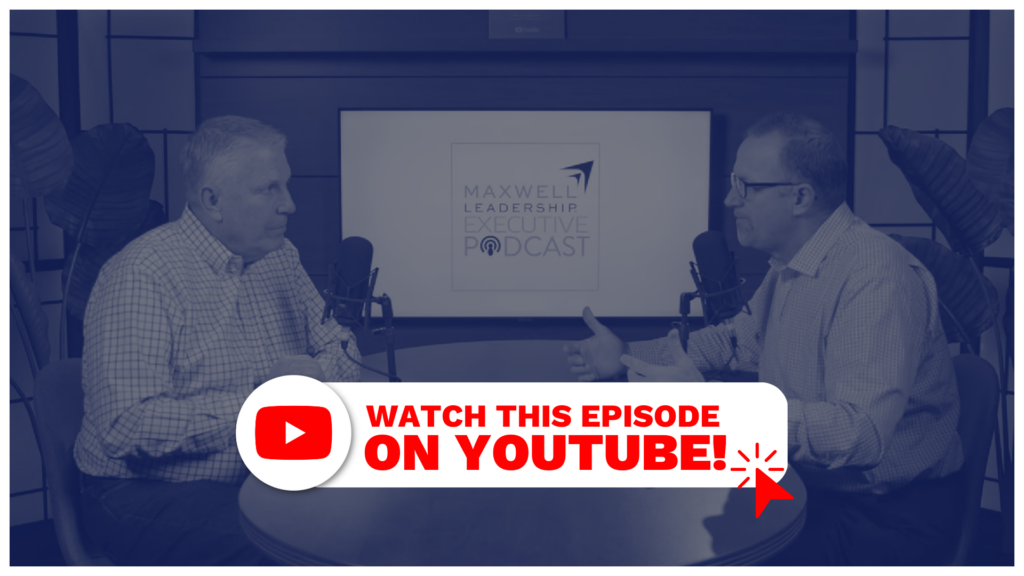Executive Podcast #250: How Can a Leader Create and Maintain Urgency?

Creating and maintaining urgency is an important aspect of leadership. Today Chris and Perry discuss a sustainable plan for nurturing a sense of urgency in your team in a healthy way.
Download our Learning Guide for this podcast!
Perry Holley:
Welcome to the Maxwell Leadership Executive Podcast, where our goal is to help you increase your reputation as a leader, increase your ability to influence others, and increase your ability to fully engage your team to deliver remarkable results. Hi, I’m Perry Holly, a Maxwell leadership, facilitator and coach.
Chris Goede:
And I’m Chris Goede, executive vice president with Maxwell Leadership. Welcome and thank you for joining us. We’re grateful that you would take the time to listen to this podcast. We love doing this. We’re in here laughing with Jake, our producer, and this is just something that we enjoy doing and recording for you. What we love even more is that not only are you learning from it, but you’re taking this and sharing it with your team and you’re sharing it with people and you’re adding value to them. That’s so important to us. And so we’re grateful for you, and we’re grateful that you’re a part of our podcast family. As we get started, if you’ll visit Maxwellleadership.com/podcast, there you can learn more about our offerings, either virtual or in person. You can also download the learner guide for this that we’ve created. And even more importantly, if you have a leadership question or a comment or something that you’re struggling with as a leader that we can help do some research and we can unpack. More importantly, we can bring to you what’s going on in the field, because I promise you, you’re not the only leader dealing with that. There are other leaders dealing with it, and we are probably walking alongside those leaders with some of those issues, and we’d love to hear you from that. Well, today’s topic is titled how can a leader create and maintain urgency? Talking about leaving a comment or a question, this is actually sent to us from a listener. Luke sent us in. It’s a great question. Luke and I love this, and we’re going to unpack this for you today and for our listeners. Well, John teaches that a leader is one who sees more than others see, who sees farther than others see, and who sees before others do. And it’s naturally for us as leaders to want to run fast, to want to run out in front of other people. Well, not in front of other people, but out in front. And what ends up happening, you know what I mean by that? What ends up happening is that we got to make sure we’re like as John talks about, when you turn around, you don’t see anybody. You’re just probably on a walk by yourself. And so we really need to think about what does this look like? And not only us have a sense of urgency, not only us to maintain that urgency, but how do we do that? How do we build that in the team to kind of speed others up?
Perry Holley:
Yeah, Luke, thanks for the question. You got me thinking. I was told, Chris, before we start the camera started rolling here that I had to work on this one. I don’t think I think about it directly. And it was a great way to get the juices going there about how do you create urgency. And Chris is right. Leaders are running at a different pace and speed. You’re generally just running faster than those around you. And that we forget sometimes that they’re not running the same speed. So John says sometimes you need to slow down and walk among the people. But I started thinking, what are some things we could do? So I have a couple of ideas, and I’m excited to get your feedback on them. But number one, first thing that really came to mind was something I think I learned in my very first leadership role was when it felt like people were running, were operating almost in slow motion compared to what I felt like I needed. I had this sense of urgency. I felt they didn’t was started looking at the question of did they have a clear why about what we were doing? I know they had a job, but no why and why they were doing the job. They didn’t know how or what they did added to the in picture. They didn’t know the importance, the relevancy of what they did and why it mattered in what we do. And I think if your team is really unclear about, I know I have a job and I come every day and I do my job, but I’m not really clear about how it fits in the bigger picture. I don’t know exactly how it leads to where we’re going. I’m just a cog in this big thing.
Chris Goede:
Yeah.
Perry Holley:
I’m not going to really have a sense of urgency about that. What’s your thought on that?
Chris Goede:
Yeah, I think what made me think about this is a client we have that’s actually a call center and has hundreds of people in the call center. And there would be times where they would watch data of how many times phone calls would just ring and ring and ring, and then it would lead to a negative or a downturn in the CSI, the Customer Service Index, and they began to cast a vision of what was important to them. And it’s a value. And the urgency of answering these calls led to us serving the customers at a different level. And so it made me think about that when you were just talking about, as leaders, we need to make sure that we’re communicating in a way that they understand the urgency behind what they’re doing. Otherwise they’re just going to say, I’m.
Perry Holley:
Here to just, why is my boss in such a hurry?
Chris Goede:
Yeah, why do we have to answer all these phone calls, right? Whatever it might be. And I think what ends up happening is a thing we call sideways energy. They may have energy, it may not be an urgent energy, but either way, if it’s urgent or it’s not. It’s sideways if you’re not communicating. That true north of how what they’re doing impacts the bigger picture of the organization. And so I absolutely love that. Another thing a leader can do to make urgency a common practice with their team is to ensure that they’re empowered to execute that role. Now, we might have some leaders that just stop listening because they don’t want to empower other people to do that because I think they’re the only ones that can make those decisions. But I promise you, if you are leading that way, you are the bottleneck. And if they’re having to wait on you to make all the decisions, now listen, there are certain things inside the organization, decisions, activities that only you can do as a leader. I promise you, it’s probably a lot less than what you think, but I want to encourage you to empower them so that they don’t have to wait for you to make decisions. And when that happens, they have a sense of urgency in being able to execute on whatever they need to do. They may wait for you to approve what they can already approve themselves. They may wait for others to act when they could have acted themselves. And every second, every minute, every day, for those that are leading teams and organizations is tied to some type of profitable return. And so we got to create that energy around that. And one way to do that is make sure they’re empowered to make decisions.
Perry Holley:
I love this word. Empowerment is easy to throw around. We hear a lot about it, but I’m not sure a lot of leaders know their role in creating an empowered team. And that if I’m waiting around or I feel like I don’t have the authority or your approval to move forward, I’m not acting in an empowered way. And so I become that bottleneck. And I’m thinking, I often asked a question on coaching calls. Do you want to see this work without you? Or do you like seeing it work because of you? And there may be some personal insecurities of I don’t want to let go. I don’t want to empower people because they need me here, they need me for this work. Well, that’s a bad place for a leader to be. And you’re going to put a real slowdown on urgency. People aren’t going to be able to go it at current pace and speed because they’re going to be waiting on you. Like you said, they’re going to be the bottleneck. Every decision has to go through you. Why is that? Why is your team not trained and equipped in a way that sets them up to move the locus of control away from you out to them so that they know they can keep moving and they’re not just spinning their tires waiting for you to show up. So I think that empowerment. If you had a why I know why we do and why I’m relevant, and I know that I’m empowered to move. All of a sudden, my urgency naturally picks up. Another thing that I think keeps people from moving quickly is there’s distractions, there’s obstacles, there’s roadblocks that get in their way. And I think a leader can do a lot. Again, this is something I really admire you for. You are always asking us when we’re having one on ones or on the group calls, you’re always asking what I need to do, what do I need to get out of your way? What’s holding you back? What’s keeping you held down? And we’re always kind of got me thinking about, are there things that I could get you out in front on that you could remove something from me that would not hinder me, slow me down, or distract me from the work I need to do? We’re on a lot of tight time frames here. We have a lot of deliverables that have to happen. And if you miss a week or you slow down, that urgency becomes almost stress filled and becomes a nagging urgency. Instead of just moving at this pace, we should be moving.
Chris Goede:
And as leaders, I think when you’re asking questions like that, you’re communicating that there is urgency. You are helping to move the ball forward as fast as possible. And I think that’s the goal is not to slow people down. They get bogged down. I want to ask you this question. I think Chris, is you put this in my notes. I think this is an interesting question that we could unpack for quite some time. Do you think you can develop a culture of urgency where it is expected and it’s appreciated? Do you think you can develop that?
Perry Holley:
I do. I think that’s very interesting. And that’s why I was looking at that when Luke brought the question, was that do we have a I almost think we have that here, is that we move quickly and we’re very client focused. We’re very out in front with the client, so everything is client driven. And what we do on this team, so we can’t just be waiting around. Clients don’t like, we have to have deliberate, they have to move. But what has to happen for that? So I thought the components to me of having a culture of urgency says that one has to be positive urgency. It can’t be negative, stress based, pushing people, demanding unreasonable timelines, those types of things. It has to be reasonable leaders.
Maxwell Leadership Growth Plan:
You know better than anyone that growth is essential if you want to make tomorrow better than today. But fitting growth into your calendar takes intentionality and self discipline. So let Maxwell Leadership help make your growth achievable. You’re invited to join thousands of worldwide leaders in using the Maxwell Leadership Growth Plan. The Maxwell Leadership Growth Plan provides you with convenient and easy to implement leadership resources, including video lessons from John maxwell all at your fingertips. Available in our Maxwell Leadership app or online. You’ll be coached by many well known leadership experts that will help you achieve your growth goals. You can even listen to this podcast right there in the app. Check it out for free today at Growth.MaxwellLeadership.com. That’s Growth.MaxwellLeadership.com.
Perry Holley:
But another thing I thought was are your processes, are your procedures how you govern, how work gets done? Have you analyzed, have you looked at those? Have you done an after action review on those? Have you best practiced those? And that if the things you’re doing are reducing those processes and procedures are reducing your ability to move quickly, it’s going to cause stress on the team and stress in the organization. So I like the idea of a culture of urgency, but it’s, I think, got to have a couple of boundaries. There a couple of yeah, I like.
Chris Goede:
What you said about it could create stress for the team or in the organization. And so we need to make sure that we have urgency around the right things, not all things right, the right things. That’s very good because what’s going to happen is around that stress, it’s going to cause a rise of concern. And what’s the saying when everything’s important.
Perry Holley:
Nothing’S urging.
Chris Goede:
And so make sure that you do create that. I think the other thing is, as I was thinking about this, is you can build it as part of the culture. My encouragement to you would be to build it in the right things, but to also build it that sense of urgency before it’s really required inside the organization. Don’t allow one pace, one tempo without urgency. And then all of a sudden the organization needs to step it up a little bit and you try to throw the throttle in full go because then it won’t come across as authentic. So think about how do we build that sense of urgency inside our organization before it is required. One question to ask, and it may be simple, but I want to make sure that we throw this out there. Is, is your team aware of the need for urgency? You talked about the why just a few minutes ago, but are they aware of it? Do they know why acting urgent in a particular matter matters? Again, you got to make sure you’re picking the right things or are they aware of your expectations when it comes to urgency? All of this is really kind of rooted in communication behind why and what is urgent inside the organization.
Perry Holley:
I was doing a lot of reading on this just in prep and found leader that used the term, my team is focused on deadlines, not productivity. So start thinking about that a minute going if you’re driven. I think I get that sometimes we have a deadline for a course that I’m developing. I know that’s going to be delivered on a certain day. Whatever my mindset is about that span. I go, I’m not really as I get closer to the deadline, it gets more urgent. But that kind of defeats the purpose, is that I want to be driven by a productivity model, not a deadline model. I thought really affected me when I read that. So, hey, I can back off that proposal. That customer is not due for ten more days. Well, what keeps us from just doing it now?
Chris Goede:
Man, that is really good, because I would say I fall in that same category. You and I joke around all the time about Tuesdays coming, and Perry, he’s done a podcast about Tuesdays coming where every Tuesday, he knew he had a deadline, and he may not be as productive early in the week, but as it got closer to screen days, it became urgent. So I think it’s a really good thing for us to think about as individual contributors and as leaders is how do we become more productive and urgent around things that matter versus allowing the deadline to drive it? That’s a really good thought. So I think leaders let me give you another thought here. Leaders need to carry that weight of the team. When we were going I was going through this content, I was thinking a lot about our CEO, Mark Cole, and how he’s leading our leadership team right now. And what you need to make sure is that this is something the team needs to carry when something becomes urgent and it’s heavy. And sometimes we’ll try to protect our people. We’ll protect the troubling data that maybe they need to be aware of, of why we need to be urgent. Coming back to some of these, we talked about where, man, can we build this before we actually get to the time so that people are acting normal? But if you don’t, then at times people are going to get a you know, they’re gonna they’re gonna get a false sense of security, of where you’re at, and then all of a sudden you show up and you’re like, no, it’s urgent. We need to have 24 sales this week, or we need to deliver this number of products or whatever. Just make sure as you’re positioning that, that the team is carrying that weight of urgency and responsibility, not just the leaders, because that becomes heavy. And leadership is sometimes a tough job, and it’s a lonely place, and I think it’s something that, as teams, we can do together, not just necessarily as the leader. So, leaders, do you need to be urgent in the right things? Yes. Do you need to model that? Yes. Because people are watching you all the time. All the time. I just want to make sure Perry is still urgent and awake as we Rabbits podcast. But you need to model that. But you don’t need to carry it by yourself. You need to allow the rest of the team to weigh in on that as well.
Perry Holley:
Yeah, the transparency is huge. I was noticing the way we run our weekly team meetings, which I’m you don’t like? I’m becoming more available. I just lied. Yeah.
Chris Goede:
To millions of downloads.
Perry Holley:
You’re lying if you but we the business review is a practice of transparency. And I’ve noticed on our team that when we have this, someone struggling or somebody needs help, I’ve noticed recently, I can help with that. Somebody on the team says, oh, you know, I had something for that. Let me help you with that. We can pick that up together. We can go with that. And that transparency, not only from leader to team, but team to team, says, it’s not just me running at a fierce pace. We all are running at a fierce pace, but let’s be real about it and let’s help each other about it and let’s carry it together.
Chris Goede:
Yeah, that’s good. Well, as we wrap up today, I want to make sure that you guys understand urgency is needed inside organizations. It’s healthy, but we can’t allow it back to what you said. We can’t allow it to stress the organization and distress the team. A couple of things just to think about, three things to think about as we kind of wrap up here. When you’re thinking about creating this culture of urgency inside the organization, go back to what Perry was talking about initially, about the why behind what individuals are doing. Make it personal for them on why their role is so important to the bigger outcome. Right? And so that is just thinking about this right here, thinking about Jake and the recording and the editing, which he just admitted to us, doesn’t have very.
Perry Holley:
Minimal with us, right?
Chris Goede:
Because it’s really, really good. But the impact that this is having on millions of people. He is urgent and he knows that that’s important because of the impact. Not because we’re sitting in here and we’re the talent in Eye Candy and also for those that are watching on YouTube, but because of the millions of people that it’s going to impact and change. There’s a nugget there. And so there’s a sense of urgency. It’s personal to him and the team on why they get that out there. The second thing is leaders. There’s a difference between having urgency and being out of control. I wrote down leaders, calm yourselves, because I have been in organizations, and you have as well, some privately held small organizations, some Fortune 500 companies, where their leaders, oh, they’re urgent, their hair is on fire and they’re running around. And so calm yourselves. Calm is contagious. A lot of things are contagious. And then finally, stay with your team. This goes to the last point that I was just making before I jumped into the wrap up. What I mean by that is stay visible. Be visible with them, be involved. Let them sense your urgency around the things that matter. That need to be urgent and the things that don’t, because if you’re not with your team and you’re not visible and they’re not aware, they’re not going to respond in the same way.
Perry Holley:
Fantastic.
Chris Goede:
Close it up for us.
Perry Holley:
Thank you, Chris. And thank you, Luke, for the question. And a reminder, if you’d like the Learner guide for this, leave a comment or a question, learn more about our offerings. You can do all of that at maxwellleadership.com/podcasts. We love hearing from you. Very grateful you’d spend this time with us. That’s all. Today. The Maxwell Leadership Executive Podcast.
To be a Successful Leader, You Need Feedback on Your Leadership.
We’re excited to announce our new and improved Organizational Effectiveness Survey (OES). The OES gathers feedback from employees to give leaders and management the knowledge and action plans needed to develop a more effective and productive work environment. Our new version measures 4 areas of your business: Leadership, People, Strategy, and Performance.













Be the first to comment on "Executive Podcast #250: How Can a Leader Create and Maintain Urgency?"